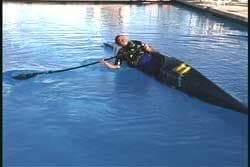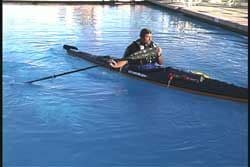Extended Paddle Roll
The extended paddle roll is a great roll for sea kayaking. The longer lever provided by using the paddle in the extended paddle position gives the paddler more support for rolling or bracing. According to Derek Hutchinson's rolling book we can thank H.W. Pawlata (known as Edi Pawlata) for doing the first Eskimo roll in Europe (1927).
This roll like many others, still depends upon the coordination of paddle movement, torso rotation and using your lower limbs to right your capsized kayak. While I would love to tell you all you need to learn this roll is on this page I cannot. After teaching hundreds of paddlers to roll I can say the best way to learn is having a trained instructor leading you through the process. I will touch on the highlights to get you started.
I have to say Kent Fords video "The Kayak Roll" has great step by step instructions, demonstrations and drills to help you if you want to practice with your friends. Even though the roll shown in Kent's video is done with the paddle in normal position the movements shown are perfect for the extended paddle roll. Just follow all of the instructions, but use an extended paddle.
As you are capsizing and you know your brace isn't going to work, tuck forward to minimize your exposure to what is under the water under your kayak. This position also gets you closer to the surface and your initial set up position. When you tuck, do so toward the side in which you will roll.
Start with hands in normal paddle position with both hands out of the water with the paddle being pushed toward the sky. Instead of going right into your rolling action, first move the paddle into the extended position. Your hands will still keep their normal distance from each other but the back hand will be holding the tip of the paddle.
The leading blade needs to stay flat on the surface (with a slight climbing blade angle) to give you the support you will need to roll you and your kayak upright. To describe it more accurately would be to say, "roll your kayak and you upright." Like any successful roll, you right the kayak and the body follows.

A good argument for 90 and 0 degree feathered paddles is always knowing where the leading blade is in space by the blade in your other hand. Other feather angles will not feel the same, because it can be difficult to know the angle of the working blade when it is offset between 90 and 0 degrees from the blade in the hand.
As you begin to sweep the leading blade out away from the bow and along the surface, you will be lifting your inside knee (the same knee as the leading hand.) Your goal is to right the kayak in a smooth motion as your brace sweeps along the surface.
The knee lift is the key to rolling your kayak up. The sweeping blade is there to give you the necessary support to right your kayak. Think of it as a moving brace. Do not pull the paddle down. Sweep the paddle out and lift the knee simultaneously.
Notice that the arms remain in the front plane of the body. The leading arm has the elbow pointing down. Proper hand and arm position will keep you from strains and/or injuries while rolling.

While you are rolling your kayak upright remember not to lead with your head. Do NOT come up head first. Let the head come up last naturally. If you try to lead with your head, you are actually keeping the kayak from rolling up.
Remember, your knee action rights the kayak while you are using your moving paddle for support.

Once upright you will find yourself in the extended high brace position which is a very supportive brace. Since you just capsized, coming up into a powerful brace position is advantageous. You can go right into an extended sculling brace to give yourself added support while you get reoriented to being upright and let the water drain from your nose. See USK article,"Extended Paddle Sculling Brace." Change back to regular paddle position when you feel comfortable to paddle off into the sunset.
You will find this roll to be very powerful. As you perfect the extended paddle roll you will find yourself upright by the time your paddle just passes the 90 degree position (3 o'clock.) This roll works very well when your kayak is full of gear and if gear is on the top deck. Those who paddle Sit On Tops and use thigh braces will find this to be the roll of choice if they ever use a roll
There are many different rolls to choose from. Since sea kayaks are larger than whitewater kayaks and definitely heavier, taking advantage of a longer lever makes a lot of sense. I recommend to learn as many rolls as you can. Once you have made the Pawlata roll a reliable one you will find it is one that will serve you well especially when the conditions get rough and your sea kayak is packed for a long trip.
I must repeat myself about practicing your roll under the eyes of someone who knows what to look for and can analyze what you are doing right and wrong. You can save yourself a lot of aggravation if you have the right help. In addition, make life easy for yourself in the learning stage. Learn in a heated pool. Wear goggles to help you with the visual. Once you can get up in the pool then take the roll into your kayaking waters, but in a calm area. Have your partner nearby to give an Eskimo assist in case you miss the roll. This could save you wasting a lot of energy from doing wet exits and recoveries.
Reading books and watching videos to help you understand what needs to be done is important. I am an advocate of a well stocked sea kayaking library. If you practice this with your friends then seriously think about Kent Ford's video mentioned earlier. If you are one of those folks who wants to learn a few different rolls then I recommend Derek Hutchinson's "Eskimo Rolling" book. Not only does it have a variety of rolls it also has great stories of the famous who blew their roll.
Pictures seen above were taken from the USK Video "Capsize Recoveries & Rescue Procedures."
Permission to use this article must be obtained from Wayne Horodowich at the University of Sea Kayaking (study@useakayak.org).
Wayne Horodowich, founder of The University of Sea Kayaking (USK), writes monthly articles for the USK web site. In addition, Wayne has produced the popular "In Depth" Instructional Video Series for Sea Kayaking.
Related Articles
I remember when I first heard about the re-enter and roll. I thought it was illogical. If I knew how to…
This is the most straightforward rescue, beyond simply righting the boat and pumping it dry. Approach…
Boat Bump The boat bump is primarily a river rescue technique. It is used to push canoes into eddies…
If you're going to hit the water on your own, you need to be comfortable with some self-rescue skills.…

